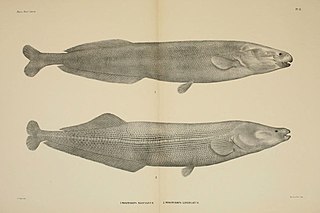
George Albert Boulenger was a Belgian-British zoologist who described and gave scientific names to over 2,000 new animal species, chiefly fish, reptiles, and amphibians. Boulenger was also an active botanist during the last 30 years of his life, especially in the study of roses.

Sardinella is a genus of fish in the family Dorosomatidae found in the Atlantic, Indian and Pacific Ocean. They are abundant in warmer waters of the tropical and subtropical oceans. Adults are generally coastal, schooling, marine fish but juveniles are often found in lagoons and estuaries. These species are distinguished by their ranges and by specific body features, but they are often confused with one another. Fish of the genus have seven to 14 striped markings along the scales of the top of the head. The paddle-shaped supramaxilla bones are characteristic; they separate Sardinella from other genera and their shapes help distinguish species. They have paired predorsal scales and enlarged fin rays.

Dorosoma is a genus that contains five species of shads, within the family Dorosomatidae. The five species are native to the North and/or Central America, and are mostly known from fresh water, though some may reside in the waters of estuaries and bays.

The Lake Tanganyika sardine is a species of freshwater ray-finned fish in the family Dorosomatidae which was endemic to Lake Tanganyika but which has now been introduced to other lakes in Africa as a food source. It is one of two species within the genus Limnothrissa, the other being the Lake Mweru endemic, L. strappersi. This species and the Lake Tanganyika sprat are known collectively as kapenta.

Limnothrissa is a small genus of freshwater ray-finned fishes elonging to the family Dorosomatidae, which also includes the gizzard shads and sardinellas. The species in this genus are endemic to Africa. It was considered to be monospecific but L. strappersi, a Lake Mweru endemic, has been recognised as a valid species. The Lake Tanganyika sardine was endemic to Lake Tanganyika but has been introduced to Lake Kivu, Lake Kariba and the Cahora Bassa reservoir.

Mormyrops is a genus of weakly electric fish in the family Mormyridae from freshwater in Africa. They are characterized by an elongate head measuring twice as long as high, and no teeth on the palate or the tongue. The genus includes the largest member of the mormyrid family, the cornish jack at up to 1.5 m (4.9 ft) in length.

Amblygaster is a small genus of sardinellas in the herring family Dorosomatidae. It currently contains four species. They are found in Indo-West Pacific regions.

Gudusia is a genus of freshwater ray-finned fishes belonging to the family Dorosomatidae, the gizzard shads and sardinellas. The fishes in this genus are found in rivers in southern Asia.

Harengula is a genus of marine ray-finned fishes belonging to the family Dorosomatidae, the gizzard shads and sarinellas/ The fishes in this genus occur mostly in the western Atlantic, Gulf of Mexico and the Caribbean Sea, with one species in the eastern Pacific Ocean. There are currently four described species.

Herklotsichthys is a genus of herrings in the family Dorosomatidae found mostly around Southeast Asia and Australia with one species each in the Persian Gulf, the Red Sea, and the western Indian Ocean. This genus currently contains 12 species.
Laeviscutella dekimpei, the roundbelly pellonuline, is a small fish belonging to the family, Dorosomatidae, which inhabits rivers and brackish lagoons in Africa. It is the only member of its genus.

Microthrissa is a genus of freshwater ray-finned fishes belonging to the family Dorosomatidae, which also includes the gizzard shads and sardinellas. The species in this genus are endemic to Africa.
Nannothrissa is a genus of very small fish in the herring family, Dorosomatidae, endemic to the Congo River system in Africa. There are currently only two recognized species

Odaxothrissa, the fangtooth pellonulines, is a genus of fresh-water fish in the family Dorosomatidae. All the extant species in this genus are found in tropical Africa.

Opisthonema is a genus of herrings, the thread herrings, found in tropical waters of the Western Hemisphere. They get their name from a filamentous nature of the last ray of the dorsal fin. Currently, five species are in this genus.

Pellonula is a small genus of ray-finned fish belonging to the family Dorosomatidae, which includes the gizzard shads and sardinellas. There are currently two recognized species in this genus. The fishes in this genus are found in Africa.
Poecilothrissa centralis, the Central Zaire pellonuline, is a very small fish of the Dorosomatidae family which is found only in Lake Tumba and the Ruki River as well as the Congo and Busira Rivers. It is the only member of the genus Poecilothrissa.

Microthrissa royauxi, the royal sprat, is a species of pelagic, freshwater fish from the herring family Clupeidae which is found in the Congo River basin in west Africa. It was described in 1902 by the Belgian-British zoologist George Albert Boulenger. It is of limited importance as a food fish in subsistence fisheries and its conservation status is Least Concern.
The bluntnosed sawtooth pellonuline is a fish species in the family Dorosomatidae, which also includes the gizzard shads and sardinellas. It is native to Central African Republic, Democratic Republic of the Congo and Republic of the Congo. The International Union for Conservation of Nature classifies this species as Least concern.

Dorosomatidae is a family of clupeiform fishes. It is now recognized by FishBase as a family in its own right; it had been considered to be a subfamily of Clupeidae. It contains 31 extant genera.













